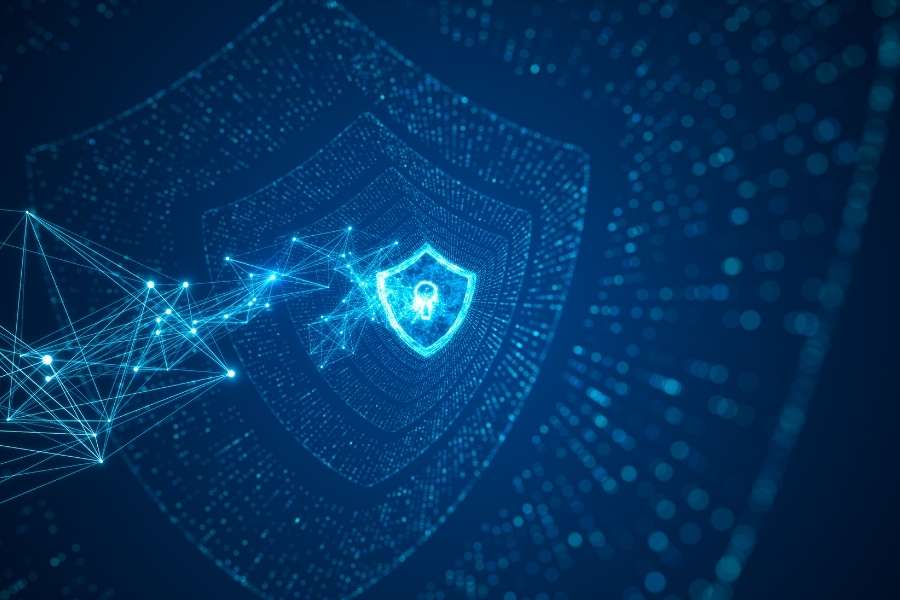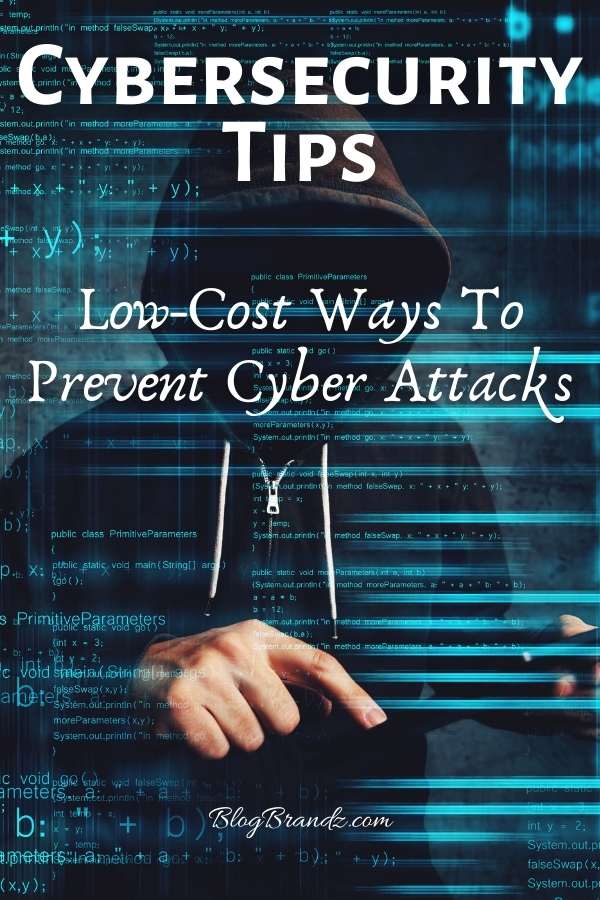Facing cyber threats and cyber-attacks? Here are some low-cost ways to improve cybersecurity, improve information security, and prevent cyber attacks.
Cybercrime is a fast-growing area of crime. Cybercriminals continue to bravely exploit the speed, convenience, advancements, and anonymity of the internet to carry out a diverse range of cyber attacks and information security attacks that spare no one, not even the most prominent organizations.
The risk of cyber threats has proved the need for cybersecurity measures in protecting data and information security. These cybersecurity threats include cyberattacks via computer hardware and software, such as the dissemination of computer malware, botnets, and viruses.
Our personal safety and information security are also threatened by network intrusions that prey on computer-based variations such as identity theft, cyber terrorism, stalking, bullying, grooming, or exploitation.
As we continue to spend a significant part of our lives using internet-based applications and technology, the increase in computer attacks, cybercrime, and security threats will continue to affect every one of us.
No one is secure. That is the cold hard reality you must face. We are all vulnerable for as long as we continue living in a world where almost all our information and data files are maintained in a digital form.
We are all vulnerable to cybersecurity threats for as long as we continue to use those social media sites to interact with our friends and families and we have seen nothing as far as cyber-attacks are concerned.
A majority of business leaders feel that cyber threats will increase and it may just be a matter of time before you are a victim unless you have not only adequate but also pugnacious measures to combat the many cybersecurity threats.
According to cyber threat intelligence experts, despite the many cybersecurity threats, many organizations have not implemented even basic cybersecurity protocols to combat the most common cyber attacks.
According to Varonis’ 2021 Data Risk Report, most establishments have vulnerable data and weak cybersecurity tools in place, making them susceptible to data risks.
According to Fortune Business Insights™, the global cyber security market is projected to grow from $165.78 billion in 2021 to $366.10 billion in 2028 at a CAGR of 12.0% in the forecast period.
Contents
- 9 Low-Cost Ways To Prevent Cyber Attacks & Improve Cyber Security
- #1. Access controls & prevention of insider threats
- #2. The role of SSL certificates in data security
- #3. Password security
- #4. Use of malware scanners & anti-malware software
- #5. Use of firewalls
- #6. Conduct regular system and software upgrades & patches
- #7. Implement cyber-ethics
- #8. Conduct regular data backups
- #9. Get cyber liability insurance
- Share this:
- Like this:
- Related
9 Low-Cost Ways To Prevent Cyber Attacks & Improve Cyber Security
We live in times of dire cybersecurity threats, and as such, understanding cybersecurity measures and protocols to deal with these cybersecurity challenges is essential for all of us.
In this article, you’ll learn some of the most basic cybersecurity fundamentals to ensure you and your data are safe. All of these cybersecurity measures are low-cost and affordable.
#1. Access controls & prevention of insider threats
Cyber insecurity cannot control itself. People must handle it within an organization. For you to control people, all you need is proper management.
Today, more and more organizations and businesses have resolved to use the distributed system where different system components are located on other networked computers.
The trend has allowed more workers to access information, including what has nothing to do with their job descriptions.
In this regard, cybersecurity is slowly becoming a less technology problem and a more people problem. Some of the major cyber attacks in the past were brewed from within the organizations’ confinements.
The management is responsible for combating cyber threats by controlling its employees’ access to system components that they do not require to fulfill their tasks.
The management should also establish a robust rapport with its employees to bring them on board and prevent bad blood that can lead to insider threats.
This is why every stakeholder within the organization should read from the same script as far as cybersecurity and cyber threat intelligence are concerned.
A splendid concept in access controls is the principle of the least privilege. This refers to the data and information security concept whereby each worker is only given the minimum level of information access and permissions needed to accomplish his task functions.
The idea is commonly valued as a cybersecurity best practice and is a central measure in safeguarding privileged access to highly treasured data, information, and assets. The concept also extends beyond human access.
The least privilege principle stretches to capture access controls to applications, systems, and networks that require permissions to conduct a given task.
The principle, therefore, remains one of the most focal points of concern in data cybersecurity. It will help with the following:
- Reduce the overall cyber-attack surface by limiting super-user and administrator privileges
- Stop the spread of malware attacks
- Improve end-user productivity
- Improve cyber threat assessment and cybersecurity assessment
- Assist in streamlining compliance and cybersecurity audits
- Implement cybersecurity for remote workers
#2. The role of SSL certificates in data security
The certificates play an essential role in establishing a secure session during data transfers and communications between web servers and web browsers. Once a website has an SSL certificate, the communication between its servers and its web browsers will happen in an encrypted form.
No hacker will decipher the gibberish-like communication unless he/she has the right key to do so. Only the rightful recipient has the key to decrypt the information.
Every website owner should install the certificate. The certificates are usually affordable and will provide the highest level of encryption, no matter their price. Even the cheapest SSL certificate will be as effective as the most expensive one.
#3. Password security
Password security is the second critical area of vulnerability in cybersecurity that is responsible for most cybersecurity breaches.
By cracking your passwords, cyber attackers can piece together all the information and digital resources that you store online and use for their malicious benefits.
By breaking your password, an attacker will access all your confidential information such as billing and shipping addresses, credit card information, health records, and personal details such as addresses and contact information.
Cybersecurity experts recommend the use of strong and unique passwords as one of the most basic cybersecurity protocols you can implement to prevent cyber attacks.
You can also mitigate cybersecurity concerns by avoiding the common password mistakes that will give hackers access to your confidential information. Here are some of the common password mistakes and their remedies:
Mistake #1: Using weak passwords
Weak passwords are those that can be guessed easily. Using a weak password is like closing your front door but failing to lock it.
Weak passwords include passwords created from familiar names, your name, your pet’s name, or sequential alphabets and numbers such as 12345 or abcde.
Remedy: The more complex a password is, the safer it is. Consider creating a password with a blend of numbers, uppercase and lowercase letters, and special characters.
Moreover, the longer the password, the safer it is. Eight to ten characters is an ideal length. Also, it will be useful to learn about more online safety practices from online courses on cybersecurity.
Mistake #2: Using similar passwords for multiple accounts
This is a critical security concern because when a hacker succeeds in cracking one password, they can easily access all your other accounts. An online security survey reveals that 65 percent of people reuse passwords on multiple sites.
Remedy: Use a different password for every account.
Mistake #3: Exposing your passwords to cybercriminals
This might mean using public computers to log into your account, writing your passwords down on a source that an intruder can easily find, or having your web browsers store your passwords.
Remedy: Avoid using public computers to access your accounts. In case you do, make sure that you log out and delete your password from the device.
Also, keep the passwords away from intruders. The best way to do that is to use tools like the Roboform Password Manager to create and save strong and unique passwords for each site.
#4. Use of malware scanners & anti-malware software
Malware scanners are essential, and the lack of them is like going up a blind alley. Malware scanners will scan through your network to try and detect and prevent malware infections.
Malware attacks are so prevalent nowadays and are giving system owners nightmares. Once you install software that has malware, then your system is bound to suffer severe consequences.
Malware attacks modify your computer system, delete valuable information, and destroy your system data. To protect your computer system from malware attacks, you will have to scan your system and install anti-malware software.
#5. Use of firewalls
A few years ago, construction personnel and architects were the only ones concerned with the use of firewalls. It described a concept where a wall would be used to contain the spread of fire.
Today, the idea has been employed in computer technology. A firewall is software or hardware that plays the role of filtering the traffic between your computer network and the internet.
Just like the brick-and-mortar firewall will be used to prevent a fire in one part of the building from reaching other regions, software and hardware firewalls will be used to ensure that if something wrong happens on one side of the firewalls, they will not spread to other computer networks within the system.
#6. Conduct regular system and software upgrades & patches
Failure to conduct regular and well-timed software upgrades can have profound security implications on your system.
The updates usually alter the way the software functions. They will fix the bugs and loopholes that could have led to cyber vulnerabilities. Never ignore those software updates.
#7. Implement cyber-ethics
It costs nothing to be responsible while using the internet. Cybersecurity starts with you.
Just like we are taught responsible lessons like “do not take that which does not belong to you,” and “do not cause any harm to others” the same way we must act in the cyber world.
While using the internet, make sure that you do not use offensive language, break into someone else’s computer system, or try out any form of cybercrime. To cut a long story short, ensure that you abide by cyber ethics.
#8. Conduct regular data backups
Last but not least, you should conduct regular backups. You do not have to go back to square one whenever a cyberattack occurs.
A backup file will keep you going even after the most dreadful cyberattack hits you. Carrying out regular backups will not cost you as much as it will cost to lose everything because of a cyberattack and not recover anything.
The ball is in your court. Start keeping a duplicate file in an alternative location before it is too late.
#9. Get cyber liability insurance
A cyber insurance policy – also referred to as “cyber risk insurance” or “cyber liability insurance” coverage – is a financial product that enables businesses to transfer the costs involved with recovery from a cyber-related security breach or similar events.
You can get Cyber Insurance or cyber liability insurance to cover both first and third-party financial losses resulting from data breaches and other cybercrimes that may compromise sensitive company and customer information.
Some of the issues that cyber liability insurance typically covers include:
- Data loss, recovery, and recreation
- Business interruption/ loss of revenue due to a breach
- Loss of transferred funds
- Computer fraud
- Cyber extortion
If you don’t want to have to hire cyber experts from top cybersecurity companies, implementing these information security tips is essential to improving cybersecurity in your organization.
In many cases, your cyber liability insurance policy can also provide access to a panel of top-tier breach coaches and the best cybersecurity companies.
As with most things, prevention is better than cure, especially since full-scale cyberattacks can have devastating consequences for your system. As of 2020, the average cost of cyber attacks or data breaches was $3.86 million.
Cyber attackers not only bark but also bite and it may just be a matter of time before they hurt you and your business. However, with these eight cost-effective tips, you can improve your cyber threat management and put up an intrepid cyber defense.
One measure is not enough, however, so make sure that you use multiple ways to improve information security, increase your IT security, and improve your small business cybersecurity protocols’ effectiveness.
As a rule, the more information, computer security measures, and cybersecurity best practices you implement, the more secure the system.
Get protection from viruses, ransomware, malware, and hackers and keep your devices secure and running smoothly with these PC and MAC privacy and security tools.
Make use of this cybersecurity information to create a cybersecurity strategy in your organization and implement the cybersecurity measures you need to protect yourself and your business from internet threats, cyber-attacks, and emerging cyber threats.
© 2021 – 2023, Priya Florence Shah. All rights reserved.
Priya Florence Shah is a bestselling author and an award-winning blogger. Check out Devi2Diva, her book on emotional self-care for women. In her spare time, Priya writes science-fiction novels and poetry and chills with her two-legged and four-legged kids.
Discover more from Business & Branding Tips
Subscribe to get the latest posts to your email.





